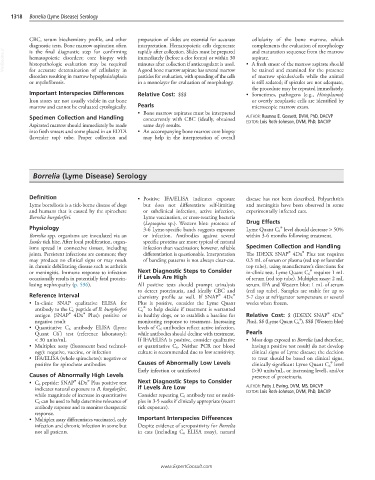Page 2602 - Cote clinical veterinary advisor dogs and cats 4th
P. 2602
1318 Borrelia (Lyme Disease) Serology
CBC, serum biochemistry profile, and other preparation of slides are essential for accurate cellularity of the bone marrow, which
diagnostic tests. Bone marrow aspiration often interpretation. Hematopoietic cells degenerate complements the evaluation of morphology
VetBooks.ir hematopoietic disorders; core biopsy with immediately (before a clot forms) or within 30 • A fresh smear of the marrow aspirate should
and maturation sequence from the marrow
rapidly after collection. Slides must be prepared
is the final diagnostic step for confirming
aspirate.
minutes after collection if anticoagulant is used.
histopathologic evaluation may be required
for accurate determination of cellularity in
particles for evaluation, with spreading of the cells
disorders resulting in marrow hypoplasia/aplasia A good bone marrow aspirate has several marrow be stained and examined for the presence
of marrow spicules/cells while the animal
or myelofibrosis. in a monolayer for evaluation of morphology. is still sedated; if spicules are not adequate,
the procedure may be repeated immediately.
Important Interspecies Differences Relative Cost: $$$ • Sometimes, pathogens (e.g., Histoplasma)
Iron stores are not usually visible in cat bone or overtly neoplastic cells are identified by
marrow and cannot be evaluated cytologically. Pearls microscopic marrow exam.
• Bone marrow aspirates must be interpreted
Specimen Collection and Handling concurrently with CBC (ideally, obtained AUTHOR: Ruanna E. Gossett, DVM, PhD, DACVP
Aspirated marrow should immediately be made same day) results. EDITOR: Lois Roth-Johnson, DVM, PhD, DACVP
into fresh smears and some placed in an EDTA • An accompanying bone marrow core biopsy
(lavender top) tube. Proper collection and may help in the interpretation of overall
Borrelia (Lyme Disease) Serology
Definition • Positive IFA/ELISA indicates exposure disease has not been described. Polyarthritis
Lyme borreliosis is a tick-borne disease of dogs but does not differentiate self-limiting and meningitis have been observed in some
and humans that is caused by the spirochete or subclinical infection, active infection, experimentally infected cats.
Borrelia burgdorferi. Lyme vaccination, or cross-reacting bacteria
(Leptospira sp.). Western blot: presence of Drug Effects
Physiology 3-6 Lyme-specific bands suggests exposure Lyme Quant C 6® level should decrease > 50%
Borrelia spp. organisms are inoculated via an or infection. Antibodies against several within 3-6 months following treatment.
Ixodes tick bite. After local proliferation, organ- specific proteins are more typical of natural
isms spread in connective tissues, including infection than vaccination; however, reliable Specimen Collection and Handling
joints. Persistent infections are common; they differentiation is questionable. Interpretation The IDEXX SNAP® 4Dx® Plus test requires
may produce no clinical signs or may result of banding patterns is not always clear-cut. 0.3 mL of serum or plasma (red top or lavender
in chronic debilitating disease such as arthritis top tube), using manufacturer’s directions for
or meningitis. Immune response to infection Next Diagnostic Steps to Consider in-clinic test. Lyme Quant C 6® requires 1 mL
occasionally results in potentially fatal protein- if Levels Are High of serum (red top tube). Multiplex assay: 2 mL
losing nephropathy (p. 596). All positive tests should prompt urinalysis serum. IFA and Western blot: 1 mL of serum
to detect proteinuria, and ideally CBC and (red top tube). Samples are stable for up to
Reference Interval chemistry profile as well. If SNAP® 4Dx® 5-7 days at refrigerator temperature or several
• In-clinic SNAP qualitative ELISA for Plus is positive, consider the Lyme Quant weeks when frozen.
antibody to the C 6 peptide of B. burgdorferi C 6® to help decide if treatment is warranted
antigen (SNAP® 4Dx® Plus): positive or in healthy dogs, or to establish a baseline for Relative Cost: $ (IDEXX SNAP® 4Dx®
negative result monitoring response to treatment. Increasing Plus), $$ (Lyme Quant C 6®), $$$ (Western blot)
• Quantitative C 6 antibody ELISA (Lyme levels of C 6 antibodies reflect active infection,
®
Quant C6 ) test (reference laboratory): while antibodies should decline with treatment. Pearls
< 30 units/mL If IFA/ELISA is positive, consider qualitative • Most dogs exposed to Borrelia (and therefore,
• Multiplex assay (fluorescent bead technol- or quantitative C 6. Neither PCR nor blood having a positive test result) do not develop
ogy): negative, vaccine, or infection culture is recommended due to low sensitivity. clinical signs of Lyme disease; the decision
• IFA/ELISA (whole spirochetes): negative or to treat should be based on clinical signs,
positive for spirochete antibodies Causes of Abnormally Low Levels clinically significant Lyme Quant C 6® level
Early infection or uninfected (>30 units/mL, or increasing level), and/or
Causes of Abnormally High Levels presence of proteinuria.
• C 6 peptide: SNAP® 4Dx® Plus positive test Next Diagnostic Steps to Consider
indicates natural exposure to B. burgdorferi, if Levels Are Low AUTHOR: Patty J. Ewing, DVM, MS, DACVP
EDITOR: Lois Roth-Johnson, DVM, PhD, DACVP
while magnitude of increase in quantitative Consider repeating C 6 antibody test or multi-
C 6 can be used to help determine relevance of plex in 3-5 weeks if clinically appropriate (recent
antibody response and to monitor therapeutic tick exposure).
response.
• Multiplex assay differentiates vaccinated, early Important Interspecies Differences
infection and chronic infection in some but Despite evidence of seropositivity for Borrelia
not all patients. in cats (including C 6 ELISA assay), natural
www.ExpertConsult.com

